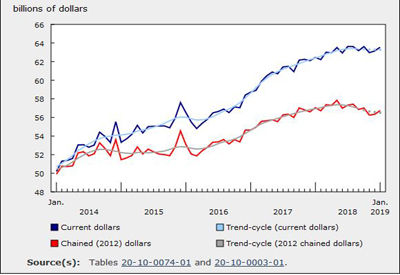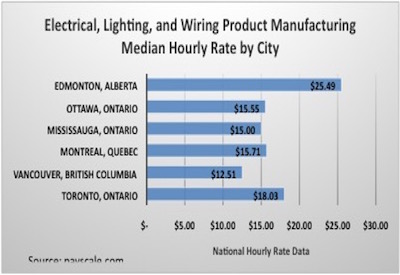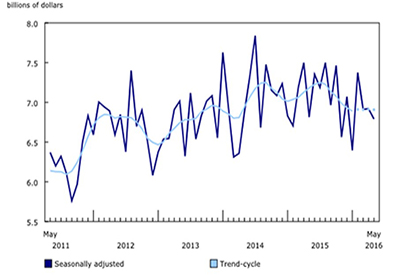Wholesales Sales Up 0.6% in January

Apr 1, 2019
Wholesale sales rose 0.6% to $63.5 billion in January, a second consecutive monthly gain. Sales were up in five of seven subsectors, representing 70% of total wholesale sales. The machinery, equipment and supplies and the personal and household goods subsectors led the gains. In volume terms, wholesale sales increased 0.7%.
Increase in January attributable to higher sales in five of seven subsectors
Following two consecutive monthly declines, sales in the machinery, equipment and supplies subsector rose 1.9% to $13.3 billion. Higher sales in the computer and communications equipment and supplies industry (+8.5%) in January offset much of the industry’s decline in December (-8.7%), while in volume terms, sales were up 7.9% in January following an 8.9% decline in December.
The personal and household goods subsector rose for the first time in three months, up 2.5% to $8.9 billion. Sales were up in four of six industries, led by the pharmaceuticals and pharmacy supplies industry (+2.8%), which accounted for 53% of sales within the subsector.
Sales in the building material and supplies subsector rose for the second consecutivemonth, up 2.0% to $9.4 billion in January. Sales were up in all three industries, led by the lumber, millwork, hardware and other building supplies industry (+3.3%).
The motor vehicle and parts subsector recorded the largest decline in dollar terms in January, down 2.1% to $10.6 billion. The decline was attributable to lower sales in the motor vehicle industry (-4.3%), offsetting the gains in the other two industries.
Sales in the miscellaneous subsector fell for the second time in six months, down 1.2% to $8.5 billion in January. Sales declined in two of five industries, with the agricultural supplies industry contributing the most in dollar terms, down 5.5% to $2.5 billion. In volume terms, the miscellaneous subsector declined 0.5% with the agricultural supplies industry falling 5.0%.
Higher sales in seven provinces
Wholesale sales rose in seven provinces in January, representing 93% of total wholesale sales. In dollar terms, Quebec and Ontario accounted for most of the gain.
Sales in Quebec rose 2.7% to $11.9 billion, led by higher sales in all subsectors. The personal and household goods subsector (+6.4%) contributed the most to the gain, following three consecutive monthly declines. The building material and supplies subsector (+3.2%) also contributed to higher sales in Quebec with its second consecutive monthly gain.
Following two consecutive monthly declines, sales in Ontario increased 0.8% to $32.4 billion. Sales were up in four of seven subsectors, led by the miscellaneous (+5.3%) and the machinery, equipment and supplies (+2.4%) subsectors.
In Alberta, sales increased 1.8% to $6.9 billion, its second gain in six months. Higher sales in the motor vehicle and parts subsector (+7.1%) contributed the most to the increase.
In New Brunswick, sales rose 7.7% to $579 million, more than offsetting the 2.5% decline in December. The food, beverage and tobacco subsector (+14.5%), which contributed the most to the decline in December (-8.6%), led the gains in January.
Sales in Saskatchewan were down 10.7% to $2.3 billion, following two consecutive monthly gains. Overall, six of seven subsectors declined, with the miscellaneous subsector (-20.1%) accounting for the majority of the decrease after reaching its highest level on record in December.
Inventories rise in January
Wholesale inventories increased for the fifth consecutive month, up 0.4% to $90.7 billion in January. Gains were reported in four of seven subsectors, representing about 49% of total wholesale inventories.
In dollar terms, wholesale inventories in the motor vehicle and parts subsector (+2.8%) posted the largest monthly gain, its fourth consecutive monthly increase. Two of the three industries within the subsector increased in January.
Inventories in the personal and household goods subsector (+2.1%) grew for the second consecutive month. Overall, four of six industries increased, with the pharmaceuticals and pharmacy supplies industry contributing the most to the gain.
Following three consecutive monthly increases, inventories in the food, beverage and tobacco subsector (-2.1%) posted the largest decrease in dollar terms. All industries were down, with the food industry contributing the most to the decline.
The inventory-to-sales ratio was unchanged at 1.43 in January. This ratio is a measure of the time in months required to exhaust inventories if sales were to remain at their current level.
Source: Statistics Canada, https://www150.statcan.gc.ca/n1/daily-quotidien/190321/dq190321a-eng.htm











